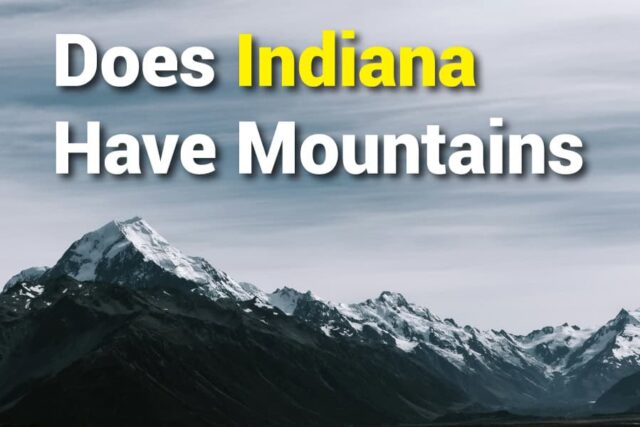Indiana, often recognized for its rich history and bustling cities like Indianapolis, may not be the first place that comes to mind when discussing mountains. However, the question arises for those curious about its natural landscape: Does Indiana have mountains? Despite being primarily known for its flatlands, Indiana has some geographical features that may surprise you. While towering peaks like those found in the Rockies or Appalachians are absent, Indiana’s landscape offers rolling hills, high points, and unique topographical features worth exploring. In this comprehensive guide, we’ll explore Indiana’s terrain, including its highest points and whether the state has anything resembling a mountain. We’ll also delve into how Indiana’s geography has shaped its culture, economy, and outdoor activities, giving you a clearer understanding of its diverse landforms.
So, if you’re wondering whether Indiana has mountains or simply seeking information on Indiana’s highest elevation points, this article is for you. Let’s dive into the geography of Indiana and uncover its natural wonders.
Does Indiana Have Mountains?
No, Indiana does not have mountains. The state’s terrain is mostly flat, with some rolling hills, especially in the southern part. The highest point in Indiana is Hoosier Hill, which reaches 1,257 feet but doesn’t compare to the towering mountains in other states like Colorado or Tennessee. Farmlands, forests, and river valleys with no mountain ranges characterize Indiana’s landscape.
Indiana’s Geographical Overview
In the Midwestern United States, Indiana boasts a landscape that’s often mistaken for being flat. At the same time, large portions of the state indeed feature expansive farmlands; there is more to Indiana’s topography than meets the eye. Stretching across roughly 36,000 square miles, Indiana is divided into several distinct geographical regions, each with unique features.
In northern Indiana, you’ll find flat plains formed by glaciers thousands of years ago. This area is known for its fertile soil, which has played a significant role in Indiana’s agricultural economy. However, as you move south, the landscape begins to change. Rolling hills emerge, especially in Brown County and the Hoosier National Forest regions.
The southern region of Indiana is home to some of the state’s most rugged terrain. Although it still doesn’t reach the heights of the mountain ranges found in other states, southern Indiana has numerous high points, ridges, and bluffs. The Ohio River carves through this region, creating steep valleys and picturesque views. Here, you’ll find Hoosier Hill, Indiana’s highest natural point, standing at 1,257 feet above sea level. While it doesn’t qualify as a mountain, it’s the closest Indiana comes to a peak.
Indiana’s topography lacks true mountains compared to states with prominent mountain ranges. However, Indiana’s diverse geography—from flat plains to rolling hills—adds to the state’s natural beauty and variety. Indiana may not have soaring mountain peaks for hikers and nature lovers, but it offers plenty of outdoor adventures through its hills, forests, and valleys.
The Hills and High Points of Indiana
Hoosier Hill: Indiana’s “Mountain”
Hoosier Hill, located in Wayne County near the Ohio border, is Indiana’s highest point at 1,257 feet. While it may not qualify as a mountain by traditional standards, it is a noteworthy feature for the state. Visitors can reach the top of Hoosier Hill via a short walk through a forested area, marked by a small monument.
The Knobstone Escarpment
In southern Indiana, the Knobstone Escarpment creates a rugged landscape with rolling hills and steep ridges. This region, particularly around the Knobstone Trail, is popular with hikers seeking a challenge, as the terrain is more strenuous than the flatlands found in northern Indiana.
Brown County State Park
Brown County State Park, often called Indiana’s “Little Smokies,” offers some of the most scenic views in the state. With rolling hills, steep ridges, and lush forests, it’s a popular destination for outdoor enthusiasts. The park’s trails take you through some of the highest elevations in the state, though none qualify as true mountains.
The Ohio River Valley
The Ohio River defines Indiana’s southern border, carving deep valleys into the landscape. While these valleys don’t create mountain ranges, they contribute to the region’s varied topography and offer beautiful, dramatic views.
Indiana Dunes
Though not mountains, the Indiana Dunes along Lake Michigan’s southern shore offer impressive dunes that rise to 200 feet. These dunes are remnants of ancient glacial activity and provide a unique landscape in northern Indiana.
How Indiana’s Geography Shapes Its Culture and Economy?
Though devoid of mountains, Indiana’s geography plays a significant role in shaping its culture and economy. Here are key factors influenced by the state’s topography:
- Agriculture: Indiana’s flat plains and fertile soil make it one of the leading agricultural states in the U.S. Corn, soybeans, and wheat are among the most important crops, contributing to the state’s economy.
- Tourism: While Indiana doesn’t have mountains, its hills, forests, and rivers draw tourists interested in hiking, camping, and outdoor activities. Areas like Brown County and the Indiana Dunes are popular destinations.
- Transportation: The relatively flat landscape makes Indiana a critical transportation hub. Major highways and railways cross the state, connecting the Midwest to the East Coast.
- Industry: The state’s flat terrain and proximity to major waterways like the Ohio River have supported the development of manufacturing and industry, especially in northern and central Indiana.
- Conservation: Indiana’s diverse ecosystems—from wetlands to forests—are protected through state parks and nature preserves, which support wildlife and offer recreational opportunities.
Why does Indiana Lack Mountains?
While Indiana may have some hilly regions, it lacks the towering mountains seen in other parts of the U.S. This can be traced back to its geological history. Millions of years ago, the region now Indiana was covered by a shallow sea, which gradually gave way to the plains and rolling hills we see today.
Indiana was also heavily impacted by glaciation during the Ice Age. The glaciers flattened much of the northern part of the state, creating expansive plains ideal for agriculture. In the southern part of the state, the glaciers stopped short, leaving behind the rugged terrain of the Knobstone Escarpment and other hilly areas.
This glaciation, combined with the lack of tectonic activity in the region, explains why Indiana has no mountains. States like Colorado and California, which sit along tectonic plate boundaries, have mountains formed by the collision of these plates. Indiana, by contrast, sits in a relatively stable part of the North American continent, far from any tectonic boundaries.
Despite the absence of mountains, Indiana’s varied landscape offers plenty of natural beauty and opportunities for outdoor recreation. From hiking in the hills of Brown County to exploring the dunes along Lake Michigan, Indiana has much to offer nature lovers.
Indiana’s Highest Points and Popular Hiking Destinations
Hoosier Hill: Indiana’s Tallest Point
Standing at 1,257 feet, Hoosier Hill is Indiana’s highest point. While it’s not a mountain, it’s a significant landmark for those seeking to reach the state’s top.
The Knobstone Trail
The Knobstone Trail is Indiana’s longest hiking trail, stretching over 60 miles. It takes hikers through rugged terrain in southern Indiana, offering a challenging experience despite lacking mountains.
Brown County State Park
Known for its rolling hills and scenic vistas, Brown County State Park is a popular destination for hiking, camping, and enjoying the great outdoors.
Indiana Dunes State Park
Located along Lake Michigan, Indiana Dunes State Park offers a unique landscape of towering dunes, some rising to 200 feet. The park is a popular spot for hiking, swimming, and birdwatching.
Clifty Falls State Park
Clifty Falls State Park, located in southern Indiana, is known for its waterfalls and rugged landscape. The park’s trails take visitors through deep gorges and along rocky cliffs, offering a taste of Indiana’s wilder side.
Final Word
While Indiana does not have mountains, its landscape is far from boring. The state’s rolling hills, rugged ridges, and high points like Hoosier Hill offer plenty of opportunities for outdoor adventure. Whether exploring the Knobstone Escarpment or hiking through Brown County State Park, Indiana’s diverse geography provides a stunning natural beauty worth exploring. So, while you won’t find towering peaks here, Indiana’s hills and high points remind you that the state has its unique charm.














